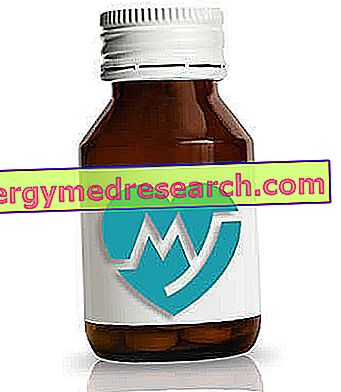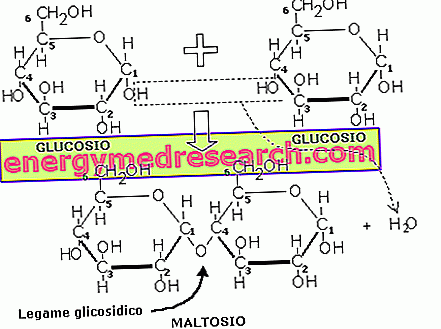What is that
Poison ivy - also known as the ivy of Canada - is a plant belonging to the Anacardiaceae family, a native of North America but also common in Asia and Europe.

For this reason, this plant is one of the most feared plant species by people who like to walk or do activities in the midst of nature.
The poison ivy drug consists of the leaves, which, given the high toxicity, find no use whatsoever except in the homeopathic field.
Curiosity
The poison ivy is also known as the " climber nettle ", since - growing on the cliffs - there are numerous climbers who come across its poisonous leaves, reporting serious skin reactions.
Botany Description
Poison ivy is an evergreen plant that can grow as a creeper, bush or small shrub, and whose stem can reach 120 cm in length.
The leaves are composed trifoliate (that is they grow in groups of three), long petiolate (8-14 cm), of oblong shape, acute or obtuse, and with entire or serrated leaf margin. The upper leaf page is bright green, while the lower page is slightly pubescent, with a lighter shade of green.

The fruits are white-yellowish globular drupes. The dimensions of the fruits may vary and contain a latex which - exposed to the air - takes on a black color.
Knowing how to distinguish the characteristic features of the poison ivy is very important in order to recognize it and, consequently, to be able to avoid it when it is encountered in nature.
Warning!
The poison ivy should not be confused with the common ivy ( Hedera helix ) with which it has absolutely nothing in common. The Hedera helix, in fact, has therapeutic properties that allow its use in the medical-pharmaceutical field (for more information, read: Edera in Herbal Medicine - Treating with Ivy ).
Composition
Chemical Composition of Poison Ivy
The main components of poison ivy (present in every part of the plant) are:
- Alkylphenols, among which the urusciolo (or urushiol) stands out;
- Tannins;
- Flavonoids.
The urusciolo is considered the main responsible of the toxicity attributed to the poison ivy. It is not a single substance, but an oleoresin consisting of a mixture of catechol derivatives. It appears as a yellow liquid, clear and immiscible with water.
Toxicity
Cutaneous toxicity of Poison Ivy
Due to the uranium contained in it, poison ivy is a very toxic plant, even by simple contact with the skin.
In fact, following contact with the plant, an allergic skin reaction develops, commonly known as " urusal-induced contact dermatitis ".
More precisely, the urusciolo causes a type IV hypersensitivity reaction (ie, cell-mediated) which leads to the appearance of a dermatitis characterized by symptoms, such as:
- Redness;
- Swelling;
- Formation of papules and vesicles with linear distribution and serous content;
- Itch;
- Smarting.
The aforementioned skin reaction may take from 2 to 10 days to occur, depending on the individual's sensitivity to the uridulum present in the poison ivy. The healing time, on the other hand, varies from two to five weeks.
Furthermore, in case of contact with the eyes, severe conjunctivitis, corneal inflammation and loss of vision may occur.
However, it is important to point out that - being an allergic reaction - not all individuals respond equally to contact with poison ivy. In fact, in some people the symptomatology manifests itself in a mild form, while in other individuals the reaction can be so severe that it even leads to the onset of fever and loss of consciousness. In a small part of the population, however, the urusciolo does not trigger any type of reaction from the immune system.
Furthermore, the intensity of the allergic reaction also depends on other factors, such as the time of contact with the poison ivy and the concentration of urusciolo inside it.
Deepening: Mechanism of action of the Urusciolo
Urusciolo has an indirect toxic effect mediated by an induced immune response.
Once on the skin, in fact, the urusciolo attacks the membrane proteins of the most superficial skin cells with which it is in direct contact, causing its structural alteration. These alterations lead the immune system to consider the skin cells affected as foreign bodies which, therefore, must be eliminated. This triggers a cell-mediated immune response that involves the activation of T lymphocytes and which leads to the appearance of contact dermatitis.
Contact Mode
In addition to direct contact of the skin with poison ivy, an individual may be exposed to the toxicity of the uranium in it through clothing or sports equipment (walking sticks, climbing equipment, etc.). The uranium in the plant, in fact, can also be deposited by contact on clothing and on any tools. In this way, therefore, intoxication occurs indirectly.
Oral toxicity of Poison Ivy
Poison ivy is as toxic as dermal as it is orally. In fact, the ingestion of the plant, especially if in high doses, causes the onset of serious symptoms, such as:
- Irritation of the mucous membranes of the gastrointestinal tract;
- Nausea and vomit;
- Diarrhea;
- Intestinal colic;
- Dizziness;
- spasms;
- Kidney damage (nephritis and hematuria).
In case of ingestion of poison ivy, it is necessary to immediately contact the medical help or go to the nearest hospital. Gastric lavage and the administration of activated charcoal can be very useful. Spasms can be treated by administering diazepam and any metabolic acidosis can be counteracted by administering sodium bicarbonate parenterally. The patient must then receive all the necessary supportive therapies and his renal function must be constantly monitored.
Curiosity
Although highly toxic to humans, there are many animal species that feed on poison ivy without experiencing toxic effects. In fact, the plant is included in the feeding of animals such as deer and birds.
However, beware of pets: poison ivy is as toxic to humans as it is to dogs and cats (both by contact and by ingestion).
Treatment
Treatment of Contact Dermatitis caused by Poison Ivy
The pharmacological treatment of contact dermatitis caused by poison ivy essentially involves the administration of corticosteroid drugs (powerful anti-inflammatories) and antihistamines (for symptom control). In some cases, the use of antibiotics can also be used to avoid the risk of bacterial superinfections.
Naturally, the use of such drugs - for which dispensing is still necessary the medical prescription - must take place only if expressly indicated by the doctor.
Useful Tips
What to do in case of contact with poison ivy
In order to avoid the occurrence of toxic effects, contact with poison ivy should be avoided. For this reason, it is very important to know the main features.
In case of contact, instead, to try to limit the skin reaction, it can be useful to follow these simple tips:
- Wash the contact area thoroughly with soap and water. Since the urusible responsible for the toxicity of the poison ivy is an oleoresin, simple water is unlikely to be able to remove it from the skin. However, if you do not have a soap on hand, the affected area should still be rinsed with water.
- If possible, within thirty minutes of contact, use specific solvents or detergents that are able to "dissolve" and completely remove oleoresin from the skin.
- After washing and cleansing the skin, it is still necessary to contact the doctor or go to the nearest emergency room, where the situation can be adequately managed.
- Wash clothing, shoes and any tools used when contact with poison ivy has occurred. In fact, the urusciolo also adheres to these objects and remains there for some time with the risk of coming into contact with them again.
Homeopathy
Use of Poison Ivy in Homeopathy
As mentioned, the only permitted use of the poison ivy is in the homeopathic field.
In detail, homeopathy uses the mother tincture of poison ivy, obtained from the leaves of the plant, which must be harvested before flowering. The mother dye, before being used, is then subjected to a long series of dilutions and dynamizations.
The use of this plant in homeopathy is allowed precisely because the mother tincture obtained from it is extremely diluted, therefore it does not cause toxic effects. However, before taking the homeopathic remedy based on poison ivy (known as Rhus Toxicodendron ), it is always good to seek advice from your homeopathic doctor.
Poison ivy is used in the homeopathic field especially for the treatment of:
- Rheumatic pains;
- Osteoarticular pains;
- neuralgia;
- Tears, sprains or injuries of muscles, tendons and ligaments;
- Lumbago;
- Sciatica;
- Rashes with blister formation, such as those of a herpetic nature;
- Inflammation and burning eyes;
- Chickenpox;
- Dry and persistent cough;
- Fever associated with asthenia and joint pain;
- Diarrhea with frequent discharges.



